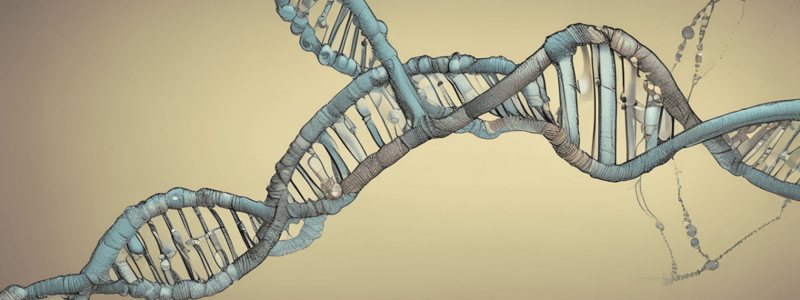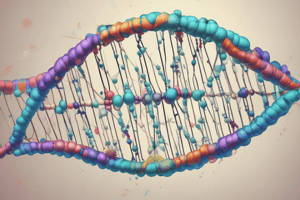Podcast
Questions and Answers
Enhancers can enhance any gene nearby by:
Enhancers can enhance any gene nearby by:
- Methylating the DNA
- Coding for regulators
- Allowing maximum level of transcription (correct)
- Blocking silencers
What is the role of silencers in gene regulation?
What is the role of silencers in gene regulation?
- Activating transcription
- Enhancing RNA processing
- Promoting chromatin compaction
- Blocking enhancers (correct)
Which process is inhibited by compact chromatin structure?
Which process is inhibited by compact chromatin structure?
- DNA repair
- Gene translation
- Transcription (correct)
- Post-translational modifications
What is the function of RISC in gene regulation?
What is the function of RISC in gene regulation?
In bacterial gene regulation, most of the regulation occurs during:
In bacterial gene regulation, most of the regulation occurs during:
What is the main role of siRNA in gene regulation during a viral infection?
What is the main role of siRNA in gene regulation during a viral infection?
'Gene regulation in Bacteria' suggests that bacterial genes require:
'Gene regulation in Bacteria' suggests that bacterial genes require:
Which type of mutation results in a stop codon?
Which type of mutation results in a stop codon?
Which DNA repair mechanism involves genetic material swapping between homologous DNA molecules?
Which DNA repair mechanism involves genetic material swapping between homologous DNA molecules?
Which mutation causes a triplet code to code for the same amino acid as before?
Which mutation causes a triplet code to code for the same amino acid as before?
Which type of mutation replaces a pyrimidine with another pyrimidine or a purine with another purine?
Which type of mutation replaces a pyrimidine with another pyrimidine or a purine with another purine?
Which DNA repair mechanism occurs before replication of the DNA and repairs double-strand breaks?
Which DNA repair mechanism occurs before replication of the DNA and repairs double-strand breaks?
Which type of mutation results in a triplet code that codes for a different amino acid?
Which type of mutation results in a triplet code that codes for a different amino acid?
Which type of mutation involves swapping a pyrimidine for a purine?
Which type of mutation involves swapping a pyrimidine for a purine?
Which hypothesis states that mutations arise from adaptations to the environment?
Which hypothesis states that mutations arise from adaptations to the environment?
What type of control does a repressor protein exert on transcription?
What type of control does a repressor protein exert on transcription?
Which type of control initiates transcription through an activator protein?
Which type of control initiates transcription through an activator protein?
What is the role of chaperone proteins in the heat shock response?
What is the role of chaperone proteins in the heat shock response?
What is a riboswitch?
What is a riboswitch?
What happens to the usual sigma factor during the heat shock response?
What happens to the usual sigma factor during the heat shock response?
What is the role of the allosteric domain in activator proteins?
What is the role of the allosteric domain in activator proteins?
What is an operon?
What is an operon?
What is the role of the DNA binding domain in repressor proteins?
What is the role of the DNA binding domain in repressor proteins?
Which of the following is a cause of spontaneous DNA mutations?
Which of the following is a cause of spontaneous DNA mutations?
What is the result of replication slippage during DNA replication?
What is the result of replication slippage during DNA replication?
What is a tautomeric shift in DNA?
What is a tautomeric shift in DNA?
What is the result of depurination in DNA?
What is the result of depurination in DNA?
Which of the following is an example of an induced DNA mutation?
Which of the following is an example of an induced DNA mutation?
What is the effect of deaminating agents on DNA?
What is the effect of deaminating agents on DNA?
What is the effect of alkylating agents on DNA?
What is the effect of alkylating agents on DNA?
Which of the following is a common cause of induced DNA mutations?
Which of the following is a common cause of induced DNA mutations?
What is the role of the Lac operon?
What is the role of the Lac operon?
What happens when glucose is present in high levels?
What happens when glucose is present in high levels?
What is the role of the CRP-cAMP complex?
What is the role of the CRP-cAMP complex?
What is the function of the LacI protein?
What is the function of the LacI protein?
What is the effect of allo-lactose on the Lac operon?
What is the effect of allo-lactose on the Lac operon?
What genes are included in the Lac operon?
What genes are included in the Lac operon?
What happens in the absence of the CRP-cAMP complex?
What happens in the absence of the CRP-cAMP complex?
What is the effect of a mutant promoter sequence (P-) on the Lac operon?
What is the effect of a mutant promoter sequence (P-) on the Lac operon?
Flashcards
Spontaneous Mutations
Spontaneous Mutations
Naturally occurring changes during DNA replication.
Replication Slippage
Replication Slippage
Template strand forms loops during DNA replication, leading to missed DNA segments.
Tautomeric Shifts
Tautomeric Shifts
Spontaneous switching between purine and pyrimidine isomers, leading to non-complementary base pairing.
Depurination
Depurination
Signup and view all the flashcards
Deamination
Deamination
Signup and view all the flashcards
Induced Mutations
Induced Mutations
Signup and view all the flashcards
Base Analogs
Base Analogs
Signup and view all the flashcards
Deaminating Agents
Deaminating Agents
Signup and view all the flashcards
Alkylating Agents
Alkylating Agents
Signup and view all the flashcards
Trans-acting Elements
Trans-acting Elements
Signup and view all the flashcards
Enhancers
Enhancers
Signup and view all the flashcards
Silencers
Silencers
Signup and view all the flashcards
RNA Interference
RNA Interference
Signup and view all the flashcards
siRNA
siRNA
Signup and view all the flashcards
microRNA
microRNA
Signup and view all the flashcards
RISC
RISC
Signup and view all the flashcards
RITS
RITS
Signup and view all the flashcards
Gene Regulation in Bacteria
Gene Regulation in Bacteria
Signup and view all the flashcards
Promoter and Operator
Promoter and Operator
Signup and view all the flashcards
Lac Operon
Lac Operon
Signup and view all the flashcards
β-galactosidase
β-galactosidase
Signup and view all the flashcards
cAMP
cAMP
Signup and view all the flashcards
CRP
CRP
Signup and view all the flashcards
LacI
LacI
Signup and view all the flashcards
DNA Repair
DNA Repair
Signup and view all the flashcards
Homologous Recombination Repair
Homologous Recombination Repair
Signup and view all the flashcards
Nonhomologous End Joining
Nonhomologous End Joining
Signup and view all the flashcards
Random Mutation Hypothesis
Random Mutation Hypothesis
Signup and view all the flashcards
Adaptation Hypothesis
Adaptation Hypothesis
Signup and view all the flashcards
Missense Mutation
Missense Mutation
Signup and view all the flashcards
Nonsense Mutation
Nonsense Mutation
Signup and view all the flashcards
Silent Mutation
Silent Mutation
Signup and view all the flashcards
Transition Mutation
Transition Mutation
Signup and view all the flashcards
Transversion Mutation
Transversion Mutation
Signup and view all the flashcards
Negative Control
Negative Control
Signup and view all the flashcards
Positive Control
Positive Control
Signup and view all the flashcards
Heat Shock Response
Heat Shock Response
Signup and view all the flashcards
Riboswitches
Riboswitches
Signup and view all the flashcards
Study Notes
Types of Mutations
- Spontaneous mutations occur naturally during DNA replication
- Replication slippage: template strand forms loops, leading to missed DNA segments and resulting in diseases like Fragile-X syndrome and Huntington's disease
- Tautomeric shifts: spontaneous switches between purine and pyrimidine isomers, causing non-complementary base pairing
- Depurination: random loss of purine, filled with adenine by DNA polymerase
- Deamination: random loss of amino group, resulting in base changes (e.g., cytosine to uracil)
Induced Mutations
- Occur due to chemical mutagens, radiation, or transposable DNA elements
- Base analogs: replace purines or pyrimidines, increase tautomeric shifts and UV radiation sensitivity
- Deaminating agents: remove amino groups
- Alkylating agents: add bulky carbon chains to bases
- Trans-acting elements: coding regions of DNA that code for regulators
- Enhancers: allow for maximum transcription level, can enhance any nearby gene
- Silencers: block enhancers, restricting enhancement to target genes
RNA Interference
- RNA-induced gene silencing: regulates translation
- siRNA: forms during viral infection, produces double-stranded RNA, cleaved by dicer
- microRNA: non-coding RNA, inhibits gene expression
- RISC: RNA-induced silencing complex
- RITS: RNA-induced transcriptional silencing complex
Gene Regulation in Bacteria
- Most regulation occurs during transcription
- Two types of transcriptional regulation: promoter and operator
- Lac operon: encodes for β-galactosidase, degrades lactose into glucose and galactose
- Lac operon is usually off, but turns on in the presence of lactose and absence of glucose
- Glucose inhibits production of adenylate cyclase, which produces cAMP
- cAMP binds to CRP, and the complex binds to the lac promoter, turning on the lac operon
- Lac operon is repressed by lacI, and induced by allo-lactose
DNA Repair
- Two types: homologous recombination repair and nonhomologous end joining
- Homologous recombination: genetic material swapped between homologous DNA molecules
- Nonhomologous end joining: occurs in G1, repairs double-strand breaks
Mutation Hypotheses
- Luria and Delbrück proved the random mutation hypothesis
- Adaptation hypothesis: mutations arise from adaptations to the environment
- Random mutation hypothesis: mutations occur randomly and not in response to the environment
Types of Mutations
- Missense: changes a base, resulting in a different amino acid
- Nonsense: changes a base, resulting in a stop codon
- Silent: changes a base, resulting in the same amino acid
- Transition: a pyrimidine replaces another pyrimidine or a purine replaces another purine
- Transversion: a pyrimidine is swapped for a purine
Gene Regulation
- Negative control: repressor protein binds to DNA, inhibiting transcription
- Positive control: activator protein binds to DNA, initiating transcription
- Heat shock response: abnormally hot temperatures activate expression of heat stress genes
- Riboswitches: noncoding mRNA segments that control downstream gene expression by binding a metabolite
Studying That Suits You
Use AI to generate personalized quizzes and flashcards to suit your learning preferences.




